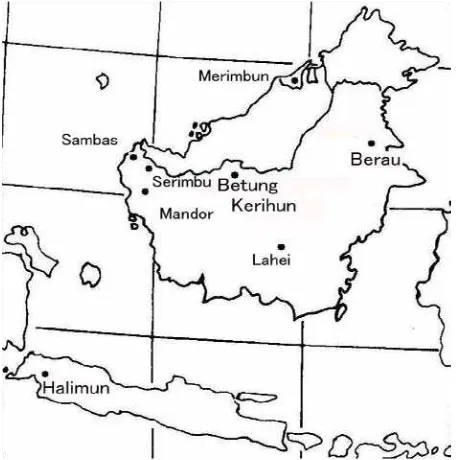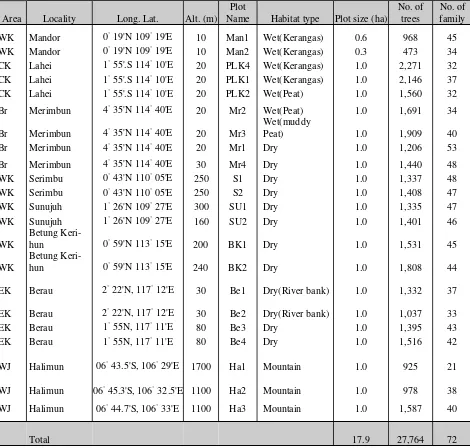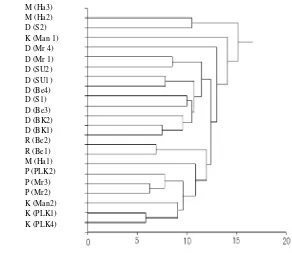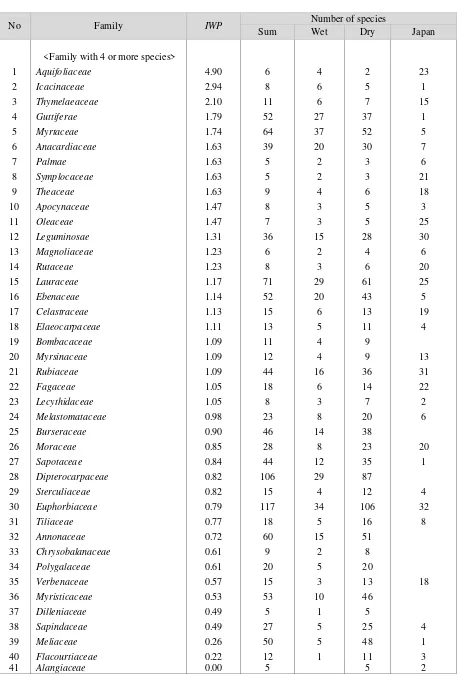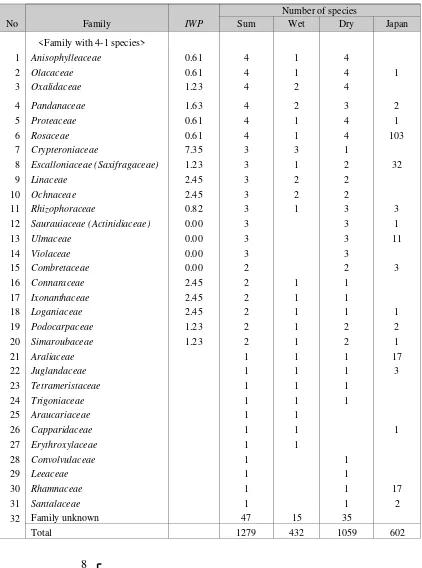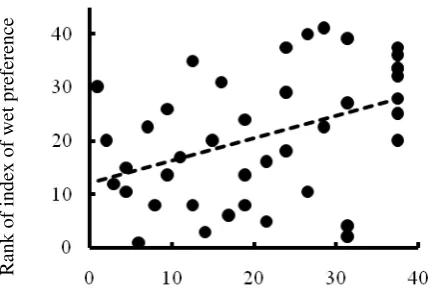REINW
ARD
TIA
13 (2)
A JOURNAL ON TAXONOMIC BOTANY,
PLANT SOCIOLOGY AND ECOLOGY
REINWARDTIA
A JOURNAL ON TAXONOMIC BOTANY
PLANT SOCIOLOGY AND ECOLOGY
Vol. 13(2): 95 — 220, November 2, 2010
Chief Editor
KARTINI KRAMADIBRATA
Editors
DEDY DARNAEDI
TUKIRIN PARTOMIHARDJO JOENI SETIJO RAHAJOE TEGUH TRIONO MARLINA ARDIYANI EIZI SUZUKI
JUN WEN
Managing editors
ELIZABETH A. WIDJAJA HIMMAH RUSTIAMI
Secretary
ENDANG TRI UTAMI
Lay out
DEDEN SUMIRAT HIDAYAT
Ilustrators
SUBARI
WAHYU SANTOSO ANNE KUSUMAWATY
Reviewers
R. ABDULHADI, SANDY ATKINS, JULIE F. BARCELONA, TODD J. BARKMAN, NICO CELLINESE, MARK COODE, GUDRUN KADEREIT, ROGIER DE KOCK, N. FUKUOKA, KUSWATA KARTAWINATA, ARY P. KEIM, P. J. A. KESSLER, A. LATIFF–MOHAMAD, M. A. RIFAI, RUGAYAH, H. SOEDJITO, T. SETYAWATI, D. G. STONE, WAYNE TAKEUCHI, BENITO C. TAN, J. F. VELDKAMP, P. VAN WELZEN, H. WIRIADINATA, RUI-LIANG ZHU.
Correspondence on editorial matters and subscriptions for Reinwardtia should be addressed to: HERBARIUM BOGORIENSE, BOTANY DIVISION,
RESEARCH CENTER FOR BIOLOGY– LIPI, CIBINONG 16911, INDONESIA
REINWARDTIA
198 [VOL.13
CORIDOR Halimun–Salak National Park (Photo: H. Wiriadinata)
REINWARDTIA Vol 13, No 2, pp: 199 − 210
199
TREE FLORA ON FRESHWATER WET HABITATS IN LOWLAND OF
BORNEO: DOES WETNESS COOL THE SITES?
Received August 17, 2010; accepted September 15, 2010
EIZI SUZUKI
Graduate School of Science and Engineering, Kagoshima University, Kagoshima 890-0065, Japan Email. suzuki@sci.kagoshima-u.ac.jp
ABSTRACT
SUZUKI, E. 2010. Tree flora on freshwater wet habitats in lowland of borneo: does wetness cool the sites?. Reinwardtia 13(2): 199–210. — The floristic records of lowland forests of Borneo in dry (not inundated) and wet (kerangas and peat swamp) habitats, and in montane forest of West Java were compared to clarify the characteristics of the flora in the lowland wet habitats. The data was flora of trees (DBH is equal to or more than 4.8 cm) in 12, 7, and 3 plots in dry lowland, wet lowland and mountain, respectively (20.9 ha in total). Plots in dry habitats had 42 to 53 families in 1 ha, except two plots on river banks (33 and 37 families). Plots in wet habitats and in mountain had 32 - 45 and 21 - 40 families, respectively. The clusters of plots in dendrogram using number of species in family mostly coincided with the difference in habitats. The preference for wet habitats existed in some families: Aquifoliaceae, Icacinaceae, Thymelaeaceae, Guttiferae, Myrtaceae, and Anacardiaceae though most families including Dipterocarpaceae and
Euphorbiaceae had no tendency. Myristicaceae, Meliaceae, and Sapindaceae preferred dry habitats. Some species consisting of the flora of tropical mountains were found occasionaly in wet habitats of lowland though very rarely in dry habitats. There was a weak but singificant correlation between preference for wet habitats and abundance in Japanese tree flora of each family. These results suggest that the wet habitat where the forest floor is periodically filled with water has cooler environment than dry habitat, and families adapted cooler climate prefer the former.
Key words: flora, Borneo, peat swamp, kerangas.
ABSTRAK
SUZUKI, E. 2010. Flora pohon pada habitat basah di dataran rendah Borneo: apakah kebasahan mendinginkan lokasi?. Reinwardtia 13(2):199–210 — Hasil penelitian floristik hutan dataran rendah di Borneo di habitat daerah kering (tidak bergelombang) dan basah (kerangas dan rawa gambut), dan di hutan pegunungan di Jawa Barat dibandingkan untuk mengklarifikasi ciri-ciri flora di habitat basah dataran rendah. Data flora pohon (dengan diameter setinggi dada sama dengan atau lebih dari 4.8 cm) pada plot 12, 7 dan 3 di dataran rendah kering, dataran rendah basah dan hutan pegunungan, masing-masing (20.9 ha jumlahnya). Plot di habitat kering mempunyai 42–53 suku per 1 ha, kecuali 2 plot di sepanjang sungai (33 dan 37 suku). Plot di habitat basah dan di pegunungan mempunyai masing-masing 32 –45 dan 21–40 suku. Pengelompokan plot dalam dendrogram dengan menggunakan jumlah jenis dalam suku kebanyakan berhubungan erat dengan perbedaan dalam habitat. Beberapa suku yang menyukai habitat basah adalah: Aquifoliaceae, Icacinaceae, Thymelaeaceae, Guttiferae, Myrtaceae, and Anacardiaceae walaupun kebanyakan suku termasuk
Dipterocarpaceae dan Euphorbiaceae yang tidak ada kecenderungan ke arah itu. Myristicaceae, Meliaceae, dan
Sapindaceae lebih menyukai habitat kering. Beberapa jenis yang termasuk dalam flora pegunungan tropika umumnya ditemukan di habitat basah di dataran rendah sangat jarang ditemukan di habitat kering. Walaupun lemah tetapi korelasi positif antara menyukai habitat basah dan kelimpahannya di flora pohon di Jepang dari setiap suku. Hasil ini menyarankan bahwa habitat basah dimana lantai hutan secara periodik berisi air mempunyai lingkungan lebih dingin dari pada habitat kering, dan suku yang beradaptasi pada iklim dingin lebih disukai daripada sebaliknya.
Kata kunci: flora, Borneo, rawa gambut, kerangas.
INTRODUCTION
Borneo and some islands in the tropical zone have wide areas of flat lowlands. With the rainy climate, many areas of flat topography become wet habitats: mangrove, freshwater swamp, peat swamp, and kerangas (tropical heath). The flora of mangrove, which is affected by the salty water, is very different from other vegetations, and is not discussed here. Freshwater swamps, and peat swamps cover
3,895,000 ha and 4,403,000 ha in Kalimantan,
respectively (MacKinnon et al. 1996.) Yamada
(1997) reviewed the studies of freshwater and peat swamp forests in Southeast Asia. He stated that there were little studies of these vegetation because
of the difficulty of approach.Whitmore (1984)
Sarawak and Sabah was made by Anderson (1963). Brunig (1974) has provided a detailed monograph and classification of heath forests of Sarawak and Brunei from 57 sampling plots. Newbery (1991) reevaluated the data of 38 plots (mostly c. 0.2 ha in size) including 636 taxa by Brunig from Brunei and Sarawak with principal component analysis. On continental part of Southeast Asia, Wyatt-Smith (1959) studied the peat swamp forest in Malaya. Suzuki & Niyomdhamn (1992) made phyto-sociological study of peat swamp in Thailand. There have been far less studies of wet habitats than those of dry habitats. To reveal the characteristics of particular vegetation, it is useful to compare it with other vegetation. This approach was rarely adopted in the floristic study of wet habitat vegetations.
The purpose of this study is to clarify the characteristics of the flora of wet habitats on lowland of Borneo by comparing it with those of dry lowland and mountain. The specimens are identified to species in most case, but not always. Long time is necessary to complete the identification. Then in this paper, the number of species in family is mainly used. Records of family level make possible to compare floral data between sites with very few common species such as Japan and Borneo.
STUDY SITES AND METHODS
The 22 study plots of 20.9 ha in total were made from 1987 to 2003 by the author and many coworkers (Table 1). All plots located in lowland
(altitude between 10 to 250 m) of Borneo (Figure 1), except three mountain plots on Mt. Halimun
National Park, West Java (Suzuki, et al. 1998). In
wet habitats, where water inundated in some seasons, seven plots were set, and the total area was 5.9 ha. Two plots (Man1, Man2, unpublished data by E. Suzuki and L. Gadrinab) were from a small nature reserve in Mandor, West Kalimantan. They
were kerangas forests with many Shorea stenoptera
Burck. Nishimura & Suzuki (2001) and Miyamoto
et al. (2003) studied the plots at Lahei, Central
Kalimantan. Kohyama et al. (2001) described the
plot in Serimbu. Plots in Merimbun Heritage Park, Brunei, Sunujuh, Betung Kerihun, and Berau were
unpublished data collected by E. Suzuki et al. In
all plots, trees equal to or bigger than 15 cm in girth (= 4.78 cm in diameter) at breast height were measured and identified.
RESULTS
Clustering of plots
Plots in dry habitats had from 42 to 53 families in 1 ha, except two plots on river banks (33 and 37 families). Plots in wet habitats and on mountain had 32–45 and 21–40 families, respectively. The plots in dry habitats were the richest in number of families. The similarity among plots was analyzed with dendrogram. There are several equations expressing (dis)similarity between sites: correlation coefficient, Euclidean distance, Standardized Euclidean distance, Generalized distance of
Mahalanobis etc (Kobayashi 1995). The correlation
2010] SUZUKI : Tree flora on freshwater wet habitats in lowland of Borneo 201
coefficient was inappropriate for this data set because it was not in a normal distribution. Because the Euclidean distance is affected by the absolute value of abundance, it can not express the dissimilarity exactly among plots if the abundance of each family is different. The Standardized Euclidean distance can avoid this defect. The generalized distance of Mahalanobis can avoid defect caused by the correlation between families, though it has the same default caused by the absolute value of abundance. Then the Standardized Euclidean distance of each plot was calculated from the data of the number of species in each family in each plot (Appendix 1), and they were clustered with group average method (UPGMA) (Figure. 2).
In most cases, the wet and dry habitats gathered in lower and upper parts of the figure, respectively.
The two in three plots on mountain in West Java were out of branch gathering the plots on lowland of Borneo, though the remainder was in the branch and more similar to plots in wet habitats than those in dry habitats. At the bottom of the figure, three plots in kerangas made a group of kerangas (PLK1, and 4 in Central Kalimantan, and Man2 in West Kalimantan) except Man1. Three plots in peat swamp made a group of Peat adjacent the group of kerangas. The two groups of kerangas and peat swamp were combined in one upper group, and it was connected with one plot on mountain in Java (Ha1). Be1 and Be2 on a river bank of dry habitats were the most similar plots to those of wet habitats. They were on flat land of sandy alluvial soil along small stream, which seemed to be an intermediate between dry and wet habitats.
Area Locality Long. Lat. Alt. (m) WK:West Kalimantan, CK:Central Kalimantan, Br:Brunei, EK:East Kalimantan; WJ:West Java.
Preference for wet habitats
Table 2 shows the number of species in each family found in plots of wet and dry habitats in lowland of Borneo. In total, 1279 species of 72 families were found. In wet and dry plots, 432 and 1059 species were found, respectively. The ratio was 0.408 (432/1059). I designate an index, Index
of wet preference (IWP) for each family as follow,
IWP = number of species in wet plot/number of
species in dry plot/0.408.
When species ratio of species number in wet plots to that in dry plots in a given family is the
same with the average of all species, IWP = 1.
When the family has more species in wet plots than
the average, IWP > 1. It can show the tendency
whether the family has more species in wet or dry habitats. In Table 2, the families are divided into two groups: one with more than four species, another with less than five species. The former and the latter are shown in upper and lower parts of Table 2. In each group, the families were arranged
in the order of IWP.
Figure 3 shows frequency distribution of IWP
for families with more than four species. The mode was near 1, and many families had species evenly in both habitat types. There was, however, a small peak in the class of 1.5–1.7 which imply the existence of family adapted to wet habitats.
i. Families preferring wet habitats
As shown in Figure 3, there was a group of
families with IWP around 1.6, I considered that
families with IWP >1.5 prefer wet habitats:
Aquifoliaceae (6 spp in total), Icacinaceae (8 spp),
Thymelaeaceae (11 spp), Guttiferae (52 spp),
Myrtaceae (64 spp), Anacardiaceae (39 spp),
Theaceae (9 spp), Palmae (5 spp), and
Symplocaceae (5 spp), Apocynaceae (8 spp), and
Oleaceae (5 spp). Though it is possible that the
families with a few species have a big value of IWP
by chance, families with many species such as
Anacardiaceae probably prefer the wet habitats.
Aquifoliaceae has only one genus, Ilex in tree
flora of Sabah and Sarawak (Soepadmo et al. (eds.)
2002). Though the species do not become tall tree
or dominant ones, Ilex cymosa Bl., I. wallichii
Hook. f. were often found in wet habitats.
Icacinaceae and Thymelaeaceae are more common
families. Stemonurus in Icacinaceae and Gonystylus
in Thymelaeaceae look to prefer wet habitats. The
latter often becomes the dominant species, and produces most valuable wood in swamp area, “lamin” in local name. These families were not so big ones as the following families, but seemed to
prefer wet habitats. Guttiferae, Myrtaceae, and
Anacardiaceae had many species, and were
common both in wet and dry habitats. Because we found these families in every plot, they seemed not
M (Ha3)
2010] SUZUKI : Tree flora on freshwater wet habitats in lowland of Borneo 203
No Family IWP Number of species
Sum Wet Dry Japan
<Family with 4 or more species>
1 Aquifoliaceae 4.90 6 4 2 23
2 Icacinaceae 2.94 8 6 5 1
3 Thymelaeaceae 2.10 11 6 7 15
4 Guttiferae 1.79 52 27 37 1
5 Myrtaceae 1.74 64 37 52 5
6 Anacardiaceae 1.63 39 20 30 7
7 Palmae 1.63 5 2 3 6
8 Symplocaceae 1.63 5 2 3 21
9 Theaceae 1.63 9 4 6 18
10 Apocynaceae 1.47 8 3 5 3
11 Oleaceae 1.47 7 3 5 25
12 Leguminosae 1.31 36 15 28 30
13 Magnoliaceae 1.23 6 2 4 6
14 Rutaceae 1.23 8 3 6 20
15 Lauraceae 1.17 71 29 61 25
16 Ebenaceae 1.14 52 20 43 5
17 Celastraceae 1.13 15 6 13 19
18 Elaeocarpaceae 1.11 13 5 11 4
19 Bombacaceae 1.09 11 4 9
20 Myrsinaceae 1.09 12 4 9 13
21 Rubiaceae 1.09 44 16 36 31
22 Fagaceae 1.05 18 6 14 22
23 Lecythidaceae 1.05 8 3 7 2
24 Melastomataceae 0.98 23 8 20 6
25 Burseraceae 0.90 46 14 38
26 Moraceae 0.85 28 8 23 20
27 Sapotaceae 0.84 44 12 35 1
28 Dipterocarpaceae 0.82 106 29 87
29 Sterculiaceae 0.82 15 4 12 4
30 Euphorbiaceae 0.79 117 34 106 32
31 Tiliaceae 0.77 18 5 16 8
32 Annonaceae 0.72 60 15 51
33 Chrysobalanaceae 0.61 9 2 8
34 Polygalaceae 0.61 20 5 20
35 Verbenaceae 0.57 15 3 13 18
36 Myristicaceae 0.53 53 10 46
37 Dilleniaceae 0.49 5 1 5
38 Sapindaceae 0.49 27 5 25 4
39 Meliaceae 0.26 50 5 48 1
40 Flacourtiaceae 0.22 12 1 11 3
41 Alangiaceae 0.00 5 5 2
Figure 3. Frequency distribution of index of wet preference (IWP) for families with five or more species.
No
Family
IWP
Number of species
Sum Wet Dry Japan
<Family with 4-1 species>
1 Anisophylleaceae 0.61 4 1 4
2 Olacaceae 0.61 4 1 4 1
3 Oxalidaceae 1.23 4 2 4
4 Pandanaceae 1.63 4 2 3 2
5 Proteaceae 0.61 4 1 4 1
6 Rosaceae 0.61 4 1 4 103
7 Crypteroniaceae 7.35 3 3 1
8 Escalloniaceae (Saxifragaceae) 1.23 3 1 2 32
9 Linaceae 2.45 3 2 2
10 Ochnaceae 2.45 3 2 2
11 Rhizophoraceae 0.82 3 1 3 3
12 Saurauiaceae (Actinidiaceae) 0.00 3 3 1
13 Ulmaceae 0.00 3 3 11
14 Violaceae 0.00 3 3
15 Combretaceae 0.00 2 2 3
16 Connaraceae 2.45 2 1 1
17 Ixonanthaceae 2.45 2 1 1
18 Loganiaceae 2.45 2 1 1 1
19 Podocarpaceae 1.23 2 1 2 2
20 Simaroubaceae 1.23 2 1 2 1
21 Araliaceae 1 1 1 17
22 Juglandaceae 1 1 1 3
23 Tetrameristaceae 1 1 1
24 Trigoniaceae 1 1 1
25 Araucariaceae 1 1
26 Capparidaceae 1 1 1
27 Erythroxylaceae 1 1
28 Convolvulaceae 1 1
29 Leeaceae 1 1
30 Rhamnaceae 1 1 17
31 Santalaceae 1 1 2
32 Family unknown 47 15 35
Total 1279 432 1059 602
0
2
4
6
8
0 0.2 0.4 0.6 0.8 1 1.2 1.4 1.6 1.8 2 2.2 2.4 2.6 2.8 >=3
N
u
mb
er
o
f
fa
milie
s
2010] SUZUKI : Tree flora on freshwater wet habitats in lowland of Borneo 205
to be specialized in wet habitats, though they have
many species there. Buchanania, Campnosperma,
and Gluta in Anacardiaceae often become the
dominant trees in swamps. Syzygium (=Eugenia) in
Myrtaceae is very diversified and taxonomically
most difficult genera, though apparently it has many species in wet habitats.
Some small families have specialists in wet
habitats. Dactylocladus stenostachys Oliver
(Crypteroniaceae), Combretocarpus rotundatus
Danser (Anisophylleaceae) are example of such
species, which often become one of the dominant canopy trees in wet habitats.
ii Neutral Families
Most families have no tendency of biased distribution in wet or dry habitats, as the
aggregating distribution of IWP around 1.0 (Figure
3). Rubiaceae, Myrsinaceae, Bombacaceae,
Fagaceae, Lecythidaceae, Melastomataceae, and
Burseraceae had IWP between 0.9 and 1.1. They
have no clear tendency. Leguminosae, Rutaceae,
M a g n o l i a c e a e , L a u r a c e a e , E b e n a c e a e ,
Celastraceae, and Elaeocarpaceae have a little
greater value of IWP. They might prefer wet
habitats a little. Moraceae, Sapotaceae,
Dipterocarpaceae, Sterculiaceae, Euphorbiaceae,
Tiliaceae, and Annonaceae had a little small value
of IWP. It is unclear whether these small
differences have some meaning or not. Even in these families, they have some species specialized
in wet habitats. In Dipterocarpaceae, Dryobalanops
rappa Becc., Shorea balangeran Vidal, S. rugosa
Heim., and S. teysmanniana Dyer ex Brandis, are
important emergent trees of wet habitats, and not
found in dry habitats. In Sapotaceae, Madhuca
motleyana J. F. Macbr. (=Ganua motleyana),
Palaquium leiocarpum Boerlage are common in
swamp forest.
iii Families preferring dry habitats
Verbenaceae, Myristicaceae, Dilleniaceae,
Sapindaceae, Meliaceae, Flacourtiaceae, and
Alangiaceae had the value of IWP less than 0.6.
Especially Meliaceae had 50 species and IWP was
only 0.25, apparently preferring dry habitats.
DISCUSSION
Clustering the plots
The dendrogram (Figure 2) separated most plots in wet and dry habitats into different clusters. The
used data was only number of species in family though it appeared to successfully separate the plots into some reasonable groups. In the montane plots, one was in the cluster of Borneo and more similar to the plots in wet habitats than those in dry habitats, though the remaining two plots were out of the cluster of Borneo. It might suggest the mountain flora was rather similar to that in wet habitats than in dry habitats in the lowland vegetations.
Preference of wet habitats
Table 2 suggests that there is some preference for the wetness of habitats at family level. Among
large families, Anacardiaceae and Meliaceae
preferred wet and dry habitats, respectively.
Dipterocarpaceae seemed to be neutral. The
taxonomic monographs usually describe the habitats for each species in addition to the taxonomic description. Though some families in Malesia have no comprehensive monographs, many families have. The number of species, which are described as growing in wet habitats (swamp, kerangas and so
on), was counted in Anacardiaceae (Ding Hou,
1978), Dipterocarpaceae (Ashton, 1982), and
Meliaceae (Mabberley et al., 1995) in Flora
Malesiana. They are bigger families with more than
100 species in Malesia. Anacardiaceae had the
highest both in IWP and in the ratio of species in
wet habitats among the three. Meliaceae had the
lowest in IWP though the second in the ratio of wet
habitats. The descriptions in monographs partly
coincides with the result of this study, but not completely. It seemed that different author described the habitats in different level. Some author seems to describe only typical habitats, another do all possible habitats. It is difficult to compare data strictly.
The resemblance to mountain flora
The dendrogram of Figure 2 suggests that the flora of wet habitats in lowland of Borneo has some similarity with mountain flora on West Java. In wet habitats, we sometimes found strange distributions of plants: exceptional distributions of mountain
flora on lowland. Acer laurinum Hassk (=A. niveum
Bl.), a common tree on Mt. Halimun, was found in lowland of Lahei, Central Kalimantan (E. Suzuki, personal observation; Simbolon & Mirmanto,
2000). Malesia area has only this species in Acer,
and widely distributed on mountains (Bloembergen,
1948). Engelharditia serrata Bl. in Juglandaceae
also has similar tendency. Syzygium are dominant
Conifers are less common in the tropical zone than in the cool temperate and boreal zone. Though they often dominate on the mountain forests such as
Kinabalu, where Dacrycapurs imbricatus de Laub.,
Dacrydium pecitinatum de Laub, Falcatiflium
falciforme de Laub. are common conifers (Aiba et
al., 2004). They are rare in the tropical lowland
especially in dry habitats. They seem to be,
however, rather common in wet habitats. Agathis
borneensis Warb. (= A. dammara Richard) was also
found in wet habitats in Lahei, and common on mountain. It has scattered distribution in upland rain forest from low elevation to 1200 m (de Laubenfels,
1986). In Podocarpaceae, I found Nageia
wallichiana O. K. (= Podocarpus blumei) (on
Halimun, Lahei and Serimbu), and Dacrydium
pectinatum (in Mandor and Lahei). De Laubenfels
(1988) mentions that “quite a number of conifers grow, sometimes in great quantity, on alluvial sand flats or on podosolized sands and stand stone (kerangas) and in peat-swamps, but they are not
always limited to such habitats, as both Dacrydium
pectinatum and Agathis borneensis are also
commonly met as scattered individuals in middle elevations rain-forest.”
Aquifoliaceae have only a genus Ilex, which is
also one of the common genera in warm temperate Japan and mountain flora of West Java. In lowland
forest, Ilex is a rare genus, but it was frequently
found in wet habitats. In peat swamp forest in
Sumatra, two species of Ilex (I. cymosa and I.
pleiobrachiata Loes.) are common (Shimamura &
Momose, 2005). In “Tree Flora of Sabah and
Sarawak (Soepadmo et al., (eds.) 2002), this family
consists of 22 species of Ilex, distributing from
mangrove, peat swamp to montane forest until altitude of 3500m. In 15 species found in lowland, seven species distribute in swamp and/or kerangas. Nearly half of lowland species grows in wet habitats. This genus (family) seems to prefer wet habitats in the tropical lowland, tropical mountain, and warm temperate forests, though it seems not to be common in dry habitats of tropical lowlands.
To explain the existence of mountain flora on
Figure 4. The relationship between abundance in Japanese tree flora and Index of wet preference among families. The rank data ordered from bigger to smaller was used.
Table 3 Rate of species growing on wet habitat from description in Flora Malesiana.
Family A. Number of all species B. Number of species
on wet habitat Rate (B/A)
Anacardiaceae 150 46 0.31
Dipterocarpaceae 386 49 0.13
Meliaceae 225 44 0.20
Data source: Ding Hou (1978), Ashton (1982), Mabberley et al. (1995)
R
2010] SUZUKI : Tree flora on freshwater wet habitats in lowland of Borneo 207
lowland wet habitats, the difference of species richness between dry and wet habitats can be considered. The dry habitats on the lowland had more species than wet habitats. It may affect the competition among species. When some mountain species try to enter the lowland, the dry habitats may have stronger competitor than wet habitats. This can also explain the resemblance of families between the wet habitats and the mountains.
The resemblance to flora in cooler zone
The resemblance of wet habitat flora in tropical lowland to that in cooler climate was considered in this section. To compare the preferences for tropical wet habitats and cool climate, the right side column in Table 3 shows number of tree species in Japanese
tree flora from Satake et al. (1989), as an
representative of flora in cooler climate of humid
Asia. All families with IWP>1.1 had tree species in
Japan though several families with IWP<1.1 did
not. Because the distribution of number of species in each family was not normal distribution, the
correlation between IWP and number of species in
Japan was analyzed with Spearman’s coefficient of rank correlation (Sokal & Rohlf, 1995). Figure 4 shows the relationship between rank of species
abundance in Japan and rank of IWP. The
coefficient was statistically significant at the level of 0.05 (r=0.416, n=41). Families with the higher
IWP seemed to be commoner in Japan.
Environment of Wet habitats
It seems that families distributing into subtropical and temperate zone in Japan prefer wet habitats in the tropical lowlands. Inside of forest in wet habitats filled with water are cooler than that in the dry habitats. Though the field works in wet habitats were more difficult and harder than those in dry habitats, one of the better conditions was its coolness, especially in the flooded forests. It may allow the growth of plants adapted to cooler climate. The wetness in wet habitats may cool the microenvironment of the forest and have some effect on the plant distribution. The plant distribution is affected not only by temperature but also by many factors. Deficit of oxygen and nutrient in the inundated soil is also one of the severe limiting factors for plants. As the result, the relationship is vague as shown in the low value of the above coefficient. The difference between dry and wet habitats in species richness or the number of the potential competitors may also have some effects on the results shown here. We need further study of plant physiology and microenvironment in
wet habitats to explain the reason for resemblance of family compositions in the lowland wet habitats, tropical mountain, and Japan.
ACKNOWLEDGEMENTS
This paper is based on many field works in Borneo and Java, Indonesia from 1987 to 2003 as the researches permitted by LIPI or activity of JICA. I thank many coworkers (Tukirin Partomihardjo, Herwint Simbolon, Ngakan Putu Oka, Edi Mirmanto, Muhammad Mansur, Lilian U. Gadrinab, Kohyama Takashi, Yamada Toshihiro, Noma Naohiko, Nishimura Takashi, Miyamoto Kazuki, Seino Tatsuyuki, Wakiyama Seiji, Nagano Toru, Kawabata Yuki, Watanabe M. Natsuki, and Fujii Sakae) for doing these researches, and the permission of research. Aiba Shin-ichiro and Watanabe M. Natsuki of Kagoshima University, and Yamada Toshihiro of Kumamoto Prefectural University gave valuable comments for the earlier draft.
REFERENCES
AIBA, S., KITAYAMA K., & TAKYU, M. 2004. Habitat associations with topography and canopy structure of tree species in a tropical montane forest on Mount Kinabalu, Borneo. Plant Ecology 174: 147 –161.
ANDERSON, J. A. R. 1963. The flora of the peat swamp forests of Sarawak and Brunei including a catalogue of all recorded species of flowering plants, ferns and fern allies. Gardens Bulletin Singapore 20: 131–228. ASHTON, P. S. 1982. Dipterocarpaceae. Flora
Malesiana Ser. 1. 9(2): 237–552.
BLOEMBERGEN, S. 1948. Aceraceae. Flora Malesiana Ser. 1. 4(1): 3–4.
BROWNE, F. G. 1952. The kerangas lands of Sarawak.
Malayan Forester 15: 61–73.
BRUNIG, E. F. 1974. Ecological Studies in the Kerangas Forests of Sarawak and Brunei. Borneo Literature Bureau, Keching, Malaysia. 238 pp. DE LAUBENFELS, D. J. 1988. Coniferales. Flora
Malesiana Ser. 1. 10(3): 337–453.
DING HOU. 1978. Anacardiaceae. Flora Malesiana Ser. 1. 8(3): 395–548.
KOYBAYASHI, S. 1995. Multivariate analysis of biological communities. Soju Shobo, Tokyo, (in Japanese). 194 pp.
KOHYAMA, T., SUZUKI, E., PARTOMIHARDJO, T., & YAMADA, T. 2001. Dynamic steady state of patch -mosaic tree size structure of a mixed dipterocarp forest regulated by local crowding. Ecological Research 16: 85–98.
MACKINNON, K., HATTA, G., HALIM, H. & MANGALIK, A. 1996. The Ecology of Kalimantan. Periplus Editions (HK) Ltd. 802 pp.
NEWBERY, D. McC. 1991. Floristic variation within kerangas (heath) forest: re-evaluation of data from Sarawak and Brunei. Vegetatio 96: 43–86.
SATAKE, Y., HARA, H., WATARI, S., & TOMINARI, T. 1989. Wild Flowers of Japan. Woody Plants. Heibonsha, Tokyo. (in Japanese).
SHIMAMURA, T. & MOMOSE, K. 2005. Organic matter dynamics control plant species coexistence in a tropical peat swamp forest. Proceedings of the Royal Society B 272: 1503–1510.
SIMBOLON, H. & MIRMANTO, E. 2000. Checklist of plant species in the peat swamp forests of Central Kalimantan, Indonesia. In IWAKUMA et al. (Eds.)
Proceedings of the International Symposium on: Tropical Peatlands. :179–190. Hokkaido Univ. and RDCB-LIPI.
SOEPADMO, E., SAW, L. G., & CHUNG, R. C. K. (eds.) 2002. Tree Flora of Sabah & Sarawak 4: 1–388. Ampang Press Sdn. Bhd., Kuala Lumpur.
SOKAL, P. & ROHLF, F. J. 1995. Biometry. (third ed.)
887 pp, W. H. Freeman and Company, New York. SUZUKI, E., YONEDA, M., SIMBOLON, H.,
FANANI, Z., NISHIMURA, T. & KIMURA. M. 1998. Monitoring of vegetational change in permanent plots on Gn. Halimun National Park. In SIMBOLON, H., YONEDA, M. & SUGARDJITO, J. (Eds.).
Research and Conservation of Biodiversity in Indonesia. 4: 60–81. LIPI-JICA-PHPA, Bogor.
SUZUKI, K., & NIYOMDHAM, C. 1992. Phyto-sociological studies on tropical peat swamps 1. Classification of vegetation at Narathiwat, Thailand.
Tropics 2: 49–65.
WHITMORE, T. C. 1984. Tropical Rain Forest of the Far East. (2nd ed.). Clarendon Press, Oxford. 352 pp. WYATT-SMITH, J. 1959. Peat swamp forest in Malaya.
Malayan Forester 23: 5–32.
2010] SUZUKI : Tree flora on freshwater wet habitats in lowland of Borneo 209
Appendix 1. Number of tree species in each family and plot.
Plot No. 1 2 3 4 5 6 7 8 9 10 11 12 13 14 15 16 17 18 19 20 21 22 Habitat type K K K K P P P D D D D D D R R D D D D M M M
Plot
Man 1
Man 2
PLK 4
PLK 1
PLK
2 Mr2 Mr3 Mr1 Mr4 S1 S2 SU1 SU2 Be1 Be2 Be3 Be4 BK1 BK2 Ha1 Ha2 Ha3
Rhamnaceae 1
Rhizophoraceae 1 2 2 1 2 1 1 1 1 1
Rosaceae 1 1 1 2 2 2 1 1 2 1
Rubiaceae 5 2 6 7 2 4 4 11 9 9 5 7 6 5 3 7 8 5 3 1 6 5
Rutaceae 2 1 2 1 2 1 1 1 2 1 2 1 2 1
Santalaceae 1 1 1
Sapindaceae 5 3 3 3 1 1 1 3 4 6 7 2 2 9 6 4 3 4 5 1
Sapotaceae 5 4 5 5 2 1 1 3 4 9 14 10 9 3 3 7 9 3 5 3 1
Saurauiaceae 1 1 1 1 1 1 1
Simaroubaceae 1 1 1 1 1 1 1 2
Staphyleaceae 1 1 1
Sterculiaceae 4 2 2 3 2 1 2 2 3 2 2 5 3 1 3 1
Symplocaceae 1 1 2 2 1 2 1 1 2 1
Tetrameristaceae 1 1 1 1
Theaceae 3 2 2 1 1 1 2 1 2 3 4 3
Thymelaeaceae 3 2 2 2 1 1 2 1 3 3 2 2 1 3 2 3
Tiliaceae 1 2 1 2 2 3 2 2 3 3 3 4 3 4 3 4
Trigoniaceae 1 1 1 1
Ulmaceae 2 2 3 3 1 1 1 1 1
Urticaceae 1
Verbenaceae 1 1 2 1 2 2 1 3 1 2 2 4 1
Violaceae 1 1 1 1
INSTRUCTION TO AUTHORS
Reinwardtia is a scientific journal on plant
taxonomy, plant ecology, and ethnobotany. Manuscript intended for a publication should be written in English represent an article which has not been published in any other journal or proceedings. Every manuscript will be sent to two blind reviewers.
Two printed copies (on A4 paper) of the manuscript of not more than 200 pages together with an electronic copy prepared on Word Processor computer program using Time New Romance letter type and saved in Rich Text File must be submitted.
For the style of presentation, authors should follow the latest issue of Reinwardtia very closely. Title of the article should be followed by author’s name and mailing address in one-paragraphed English abstract of not more than 250 words. Keywords should be given below each abstract. On a separated paper, author(s) should send the preferred running title of the article submitted.
Taxonomic identification key should be prepared using the aligned couplet type.
Strict adherence to the International Code of Botanical Nomenclature is observed, so that taxonomic and nomenclatural novelties should be clearly shown. Latin description for new taxon proposed should be provided and the herbaria where the type specimens area deposited should be presented in the long form that is name of taxon, author’s name, year of publication, abbreviated journal or book title, volume, number and page.
Map, line drawing illustration, or photograph preferably should be prepared in landscape presentation to occupy two columns. Illustration must be submitted as original art accompanying, but separated from the manuscript. On electronic copy, the illustration should be saved in jpg or gif format at least 350 pixels. Legends or illustration must be submitted separately at the end of the manuscript.
REINWARDTIA
Vol. 13. No. 2. 2010CONTENTS Page
HARRY WIRIADINATA & RISMITA SARI. A new species of Rafflesia (Rafflesiaceae)
from North Sumatra ………..……….. 95
ARY P. KEIM. A new species of Freycinetia (Pandanaceae) from Papua New Guinea……… 101
ROBERT GRADSTEIN et al. Bryophytes of Mount Patuha, West Java, Indonesia………... 107
ABDULROKHMAN KARTONEGORO & J. F. VELDKAMP. Revision of Dissochaeta
(Melastomataceae) in Java, Indonesia………...……… 125
NURSAHARA PASARIBU. Two new species of Freycinetia (Pandanaceae) from Sumatra,
Indonesia……….... 147
ARY P. KEIM. & M. RAHAYU. Pandanaceae of Sumbawa, West Nusa Tenggara, Indonesia... 151
K. MAT-SALEH, RIDHA MAHYUNI, AGUS SUSATYA, J. F. VELDKAMP. Rafflesia
lawangensis (Rafflesiaceae), anew species from Bukit Lawang, Gunung Leuser National Park,
North Sumatra, Indonesia... 159
J. F. VELDKAMP & R. M. K. SAUNDERS. Goniothalamus tripetalus (Lam.) Veldk.
& R. M. K. Saunders (Annonaceae), comb. nov. ... 167
M. M. J. VAN BALGOOY. An updated survey of Malesian Seed Plants Families... 171
NURHAIDAH IRIANY SINAGA. Two new species of Freycinetia (Pandanaceae) from
Manokwari, West Papua ... 183
NURHAIDAH IRIANY SINAGA, RITA MEGIA, ALEX HARTANA & ARY PRIHARDHYANTO KEIM. The ecology and distribution of Freycinetia Gaud. (Pandanaceae; Freycinetoideae) in the
Indonesian New Guinea... 189
EIZI SUZUKI. Tree flora on freshwater wet habitats in lowland of Borneo: Does wetness cool the sites.. 199
NANDA UTAMI & HARRY WIRIADINATA. Impatiens mamasensis (Balsaminaceae), a new
Species from West Celebes, Indonesia... 211
M. ARDIYANI, A. D. POULSEN, P. SUKSATHAN, F. BORCHSENIUS. Marantaceae in Sulawesi... 213
Reinwardtia is a LIPI acredited Journal (258/AU 1/P2MBI/05/2010)
Herbarium Bogoriense Botany Division
